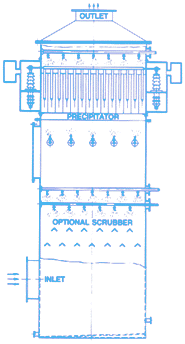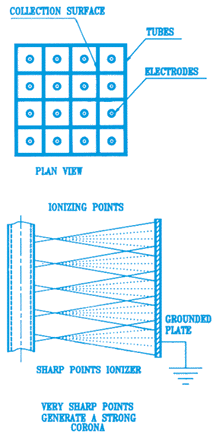| By running intermittently or continuously
wet, the unit is being washed while in operation.
Therefore, down time for washing is no longer necessary.
If required, the cells can be cleaned by compressed air or rapping or shaking,
in lieu of water or process liquor.
The tubular cell configuration lends itself to higher
face velocities. For equal efficiencies, the tubular precipitator will
be able to handle a greater volume of exhaust, thus a more compact design.
This feature is magnified when the electrostatic precipitator is allowed
to run continuously wet.
Re-entrainment problems due to highly resistive or
highly conductive materials have been eliminated by operating the precipitator
wet. As soon as the particle adheres, it is swept away.
Because of its "insensitivity to wetness", the precipitator
can be installed down stream from existing wet scrubbers, bringing these
scrubbers into compliance with today's more stringent codes.
Due to the high efficiency of the precipitator, pressure
drops across an existing high-energy scrubber (such as a Venturi) can be
lowered. Dramatic energy savings are thus realized while upgrading the
system's performance.
Beltran can supply an optional scrubber (or carbon
bed) in combination with the precipitator. This will enable the system
to control gaseous as well as particulate emissions.
Although aluminum and steel are the standard material
of construction, the cells and the precipitator can also be constructed
of corrosion resistant material. These include stainless steel, fiberglass
reinforced plastic (including the cells), or exotic metals such as zirconium
or titanium. |

![]()
![]()
![]()

